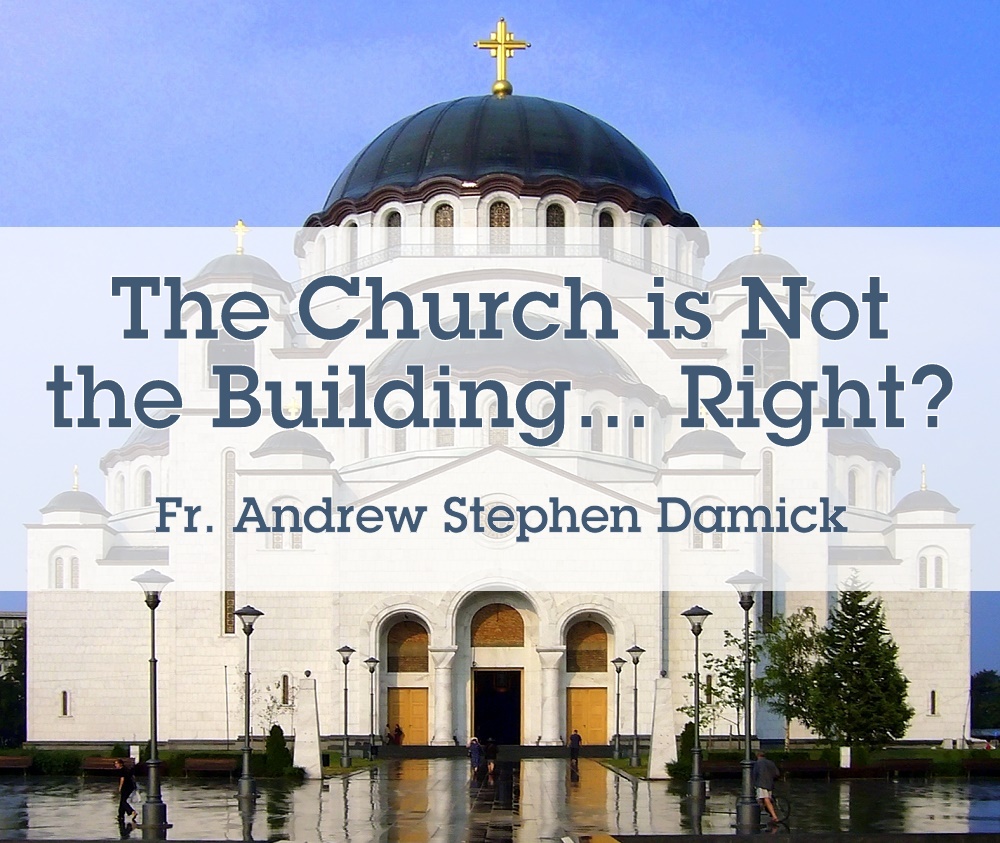
I hate it when people say that. Yes, there is a certain truth to the statement The Church is not the building. But it is usually said in the context of talking about buildings, and so what is meant by it is not really a counter of an obviously ridiculous idea, namely, that the Church is equal to a building.
It is somewhat ironic, of course, that the English word church descends etymologically from the Greek kyriakion (“the Lord’s house”), which explicitly refers to the building. But of course now we use Church to refer also to the Ekklesia, the gathered, called-out assembly of the people of God. So, this saying, The Church is not the building, is emphasizing this latter meaning and suggesting that the earlier one is somehow wrong. But of course it is wrong in the sense that people seem to think that the Ekklesia is equal to the kyriakon, that the Church is identical to a building.
But who actually thinks that? Is there anyone who believes that the Christian faith and tradition are about buildings? I don’t think even church architects actually think that. Yes, of course, it does not matter if I have a spiritual life, love God, love my neighbor, or grow in holiness, just so long as I have a nice building to keep and maintain!
Yes, of course, we know people who act that way, but the problem there is not with the building, just as the problem with a dysfunctional home life is not your house. No, saying The Church is not the building is not a serious statement of policy—I’ve never known someone who said that who wanted to move all church services outdoors—but it does present a problematic dichotomy, and it’s also rooted in a certain bad theology of its own.
One of the inheritances of the streams of Christian theology whose origins flow from 16th century Western Europe is a deliberate de-emphasis on the matter of, well, matter. As many Christians stopped believing that sacraments (ritual acts by which God communicates grace) actually do anything, iconoclasm (“image-breaking”) also came alongside. Much of the physical side of being spiritual came to be regarded as idolatry and was shunned in favor of what was summarized in the motto “four bare walls and a sermon.” Salvation was for people’s hearts and souls, and pretty buildings, vestments, iconography, bread, wine, oil, water, etc., had nothing at all to do with it, because those things pertain to the body and not the soul.
Right?
This theological attitude finds its roots originally not in Christian theology but in pagan theology, particularly the dualism that was characteristic of the philosophers who opposed the prevailing polytheism of their time. Dualism’s essential idea is that “spiritual” things are good, but physical things are bad (or at least of a much, much lower importance).
Historic Christianity is not dualist. Orthodox Christians believe that man—being a union of both body and soul—is not a soul trapped in the prison of the body. Rather, he is a body just as much as he is a soul, and even if the union of the two has suffered and will suffer because of the disruption of the Fall of Mankind from the time of Adam and Eve, that essential union remains and will eventually be fully healed in the universal resurrection that is to come.
What that means is that physical stuff has a spiritual side to it. And if that is the case, then that means that church buildings have a spiritual character, too. We can see this basic intuition in all of mankind, not just traditional Christianity. Everywhere one goes, buildings meant for religious usage have a special character and usually a special beauty to them. Even among the very poor, there is a desire to impart a particular beauty in the place where prayers are said.
For Orthodox Christians, the church building and all that adorns it are icons—they are physical images that connect us with spiritual reality. We don’t worship such things, because only God is due worship, but we do pay them honor and treat them in a special way, because they put us in touch with the divine in a way that our emotions, intellect and imaginations alone cannot.
Ironically, iconoclastic Christianity still makes use of some very physical elements—how could it not? One typically finds sermons and music in such churches, aural expressions making use of the vibrational and resonant properties of physical matter. Orthodoxy takes the very necessity of physicality in worship and all spiritual life to its fullest and most natural conclusions. The body is intimately connected with the soul, and so what you do with the one will affect the other.
For Orthodoxy, this intuition that our species has, that the physical and spiritual have very much to do with each other, was fulfilled in the incarnation of Jesus Christ, that everlasting moment when the invisible, incorporeal, untouchable, ineffable God became visible, embodied, touchable and approachable. God became man, and so physical matter received the possibility of becoming sanctified and sanctifying. He did it all the time when He was here visibly—not just by taking on a body, but with very physical actions in order to effect real changes, e.g., turning water to wine, smearing mud on a blind man’s eyes, raising the dead, etc.
So, no, the Church is not the building. The people are the Church. We get that. But there’s a reason they built that building, and it’s not just a container. There is something there that speaks of the power and majesty and closeness of God, something that connects us to Him in a way that nothing else can. And Orthodox Christians believe that God will not only honor that intention from His creatures, but will respond and, once again, use the physical to affect the spiritual. It is He Who consecrates the building to become a church (kyriakon) where the Church (ekklesia) gathers for prayer.
What does the building your faith uses for prayer convey about what you believe? Does it connect you with Heaven? Does it connect you with God? It will affect you one way or another, because you are present there. So how are you being affected by the physical context of your prayer?




I think what I appreciate most about this article is its balance. And yes I get it too.
You are in error, sir.
Would you mind expanding on that?
Where is this found in the Bible, Please give me the scriptures .
Which specific idea were you asking about? There are certainly plenty of references in Scripture to people worshiping the one true God in a building designated for that purpose.
Fr. Andrew, thank you for your article.
For me, “church” is similar to the word “home.” When I think of home, it invokes the house, furnishings, family and friends, familiar sounds and scents, and other memories. I can tease each of them out as distinct and separate ideas. However, that is not how I experience it. The reality of it is that they overlap, interact and commingle to form what I experience as “home.”
Patrick
I don’t know if this blog post was brought about because of the fire at St. Sava Cathedral in New York, but with the churches that burned on Pascha, this certainly does seem timely. On the Facebook page of St. Sava, plenty of people have commented “Well, it’s just the building; it’s the people that make the Church”, but you can’t tell me that there isn’t something profound in walking into a church like that and feeling a profound sense of God. The building itself was 160 years old, and even before it belonged to St. Sava, it was the place of those prayers, those weddings, those funerals, those people who devoted their lives to the Church, etc. These kinds of buildings serve as a connection to all those people as well. And so it is fortunate, yes, that no one was killed in the fire, and yes, the parish still exists. However, there is something profoundly sad about seeing the ruins of St. Sava as they stand now, and I think that many people, even if they aren’t terribly religious, “get” that at some level.
This piece is a rewrite of a piece I did five years ago. I didn’t have the church fire in mind, but of course there are related themes.